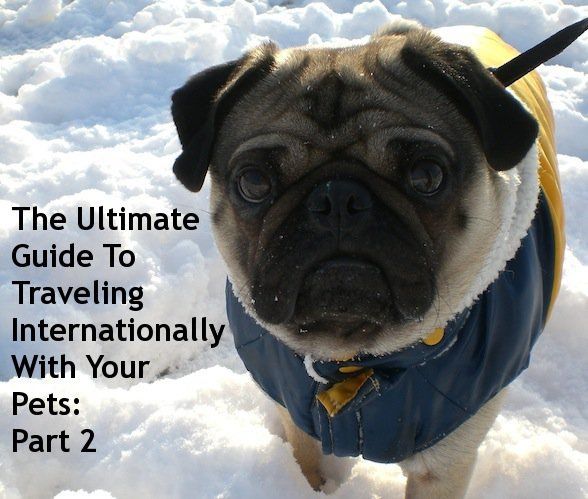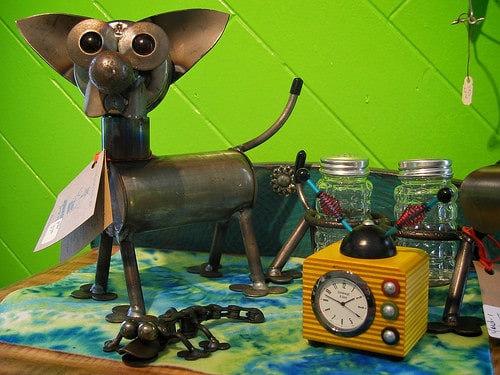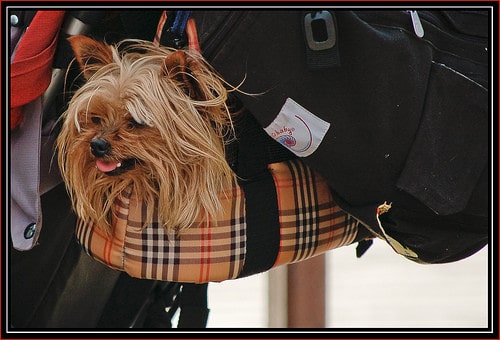In Part 1 of The Ultimate Guide To Traveling Internationally With Your Pets you learned that most of the work you have to do takes place well before you ever get to the airport. Once the paperwork is out of the way it’s time to book a flight and actually take your trip with cat or dog in tow.

Booking A Flight With Pets – Including Expected Costs
Begin searching for your flight tickets as you would any trip without pets; about 2-4 weeks in advance without booking anything just yet. Also, I strongly recommend you stick to a single airline, even if it’s more expensive. Each airline has various requirements for the transportation of pets, plus you want as little switching along the way as possible.
- Pet Travel has a good list of individual airline pet rules.
Direct flights are also ideal – they tend to cost more but are less stressful than multiple flights for your pets.
 Once You’ve Found The Right Flight: Step By Step
Once You’ve Found The Right Flight: Step By Step
- Go to the airline website and find out what their pet policy is.
- Look specifically for crate dimension requirements, booking deadlines, and beware of airline breed restrictions. (That last point is especially important if you have a dog with a reduced snout like a boxer or a pug. Some airlines won’t fly them due to their breathing problems which can be amplified in pressurized airplane environments.)
- Based on that information decide if your pets can (or should) be with you in the cabin. Here are the differences between traveling with pets in-cabin, as baggage, or cargo.
- Call the airline directly and let them know that you’ll be traveling with pets. Usually if your pets are not going to be in the cabin, you can book before, and then call to let them know. For in-cabin pets call before booking anything.
Typically only two pets are allowed in the cabin on any given flight so let the airline representative know that’s your intent. Also let them know the dimensions of your crate or carrier, breed specifics, and ask what the additional costs are.
What It Costs To Fly With Pets
Putting aside for the moment any additional costs, like visits to the vet and new crates, an in-cabin pet generally runs anywhere from $100-150 and animals checked as baggage about $150-250. Some airlines charge you per kilo of the total carrier-pet weight and you will (almost) always pay any pet costs when checking in; not when you book.
 24 Hours Before Flight Time
24 Hours Before Flight Time
Every pet is of course different, but stop feeding them around 12-24 hours before your trip and go easy on the water several hours before flight time. Being hungry is inconvenient but a full bladder or crate full of poop at 10,000 meters is worse.
- Pack enough food to feed your pet for the first day or two of after arrival.
- Have a favorite toy or chewing bone for your dog’s crate. Make sure the bone isn’t real (synthetic only) and that the crate contains no grass, hay, or any food items.
It might be difficult to find a pet store with everything you need right away so best be prepared – and don’t forget your pet’s vet and medical records!
 Checking In At The Airport
Checking In At The Airport
The process for checking in with a pet is slightly different than when you’re traveling human-only. You’ll get to the counter, show the required documents for your pet, and pay all of the additional booking fees. Your pets (in crate) will also be weighed, which is why you shouldn’t lie about Fido’s extra 5 kilos.
Hopefully you’re prepared with a leash or are comfortable holding your traveling cat, because the crates are run through an individual X-ray. Pets don’t go through the machines themselves so you’ll need to hold on to them for a few minutes while security does finishes its checks.
- Pets traveling in-cabin with you will need to have their carriers go through the X-ray machines at the security line. Usually you can hold your pet as you walk through the personal X-ray machine; ask the airport staff to confirm.
- Pets being checked as baggage should have ‘special cargo’ or ‘live animal’ tags added to their crates; make sure they’re there before the final check-in.
- Here’s the process of taking a small dog on a plane.
Once security is done, your pets will be checked-in and you won’t see them again until you land at your final destination. Upon arrival at the airport your pets will be brought to you at the baggage claim by airline staff.
 Arriving At Your Destination And Going Through Customs
Arriving At Your Destination And Going Through Customs
Most travelers with pets worry about this part, customs at arrival, most when thinking about traveling internationally with their pets. In fact, it’s generally the easiest part, assuming you’ve got all of your vet papers and required documents in hand. It’s usually less hassle traveling from the US or Europe to other places but if you’ve met the requirements, customs is often a quick glance-and-go process.
A Few Other Pet Travel Tips
- There are 4 airlines your pets can earn frequent flyer miles on, one of 7 ways to bump up your frequent flying mileage.
- Check for any pet-friendly hotels at your destination. GoPetFriendly is one of 5 useful pet travel websites.
- Thinking of getting a pet? These are 4 things frequent travelers need to consider before getting a dog or a cat.
- Some tricks to keep your cat happy while you travel.
Hopefully at this point you’re beyond customs and well on your way to your new home or vacation spot. Your pets will be stressed but these feelings pass quickly once a daily routine and the comfort of home is established. If you’ll be traveling anytime relatively soon after this, don’t neglect to make those vet appointments for the next stop. Fortunately, this seemingly formidable process becomes much easier after you’ve gone through it once, for both you and your pets.
[photos by: Big Dubya (cat eating dollar bill), Ross Belmont (dog clock), racieur (traveling dog in carrier),












My husband and I flew our dog home from Kenya, and it was much, much easier than I ever anticipated (though still quite pricey). One of the things that really helped us is that we chose a vet in Nairobi who had a lot of expatriate clients so she was very versed in the laws and needs of animals that would be flown overseas. She gave us the rundown of what we needed and then she took care of everything for us. When we picked our dog up, she handed us an envelope packed with paperwork and we were on our way. So I guess my advice is to inquire with your vet about how much experience he/she has in this area and choose one that can help guide you through the process. Also, I highly recommend flying through Amsterdam on KLM as they have a pet hotel for animals with layovers.
I did not know that! Does KLM arrange that for you or is it something you have to set up separately somehow?
Reminds me of Petairways, wish they flew international…
People can’t actually go to the pet hotel. It’s in a separate, isolated part of the hotel because animals have to be quarantined in Europe. As I understand it, though, there are staffers in the pet hotel who clean the kennels, walk and feed the dogs, etc. We could tell this was the case as the blankets in our dog’s kennel were in a different order when we arrived in Minneapolis, meaning they’d all been taken out and (we could tell) washed during our layover.
We flew KLM, so I guess I’m not sure if this is a service of KLM or the Amsterdam airport, but I believe Amsterdam is a hub for KLM, so maybe that has something to do with it.
Wow, I will definitely keep that in mind and research it further. Thanks for letting me know, I think even that little break is probably a *huge* relief to flying dogs.
A reader just emailed me to point out that US>EU>US pets don’t typically require quarantines and wanted me to mention it.
Did you have to tell them to put your pets in a hotel or do they do it automatically . Taking my 4 month old puppy from Bombay to San Fran and I’m freaking out.
I totally have to send this series on to Dave’s mom. She wants to travel more, but has here dog to think of, this is going to help lots! Thanks Anil.
Anytime! If she has any questions tell her to get in touch with me 🙂
That first picture oozes cuteness! I didn’t know that they limit the number of pets on a flight in the cabin – but I guess that makes sense! When I traveled with my cat before – I found it to be way more stressful for me than my cat!
He was a tough little model to work with but all the top ones are 🙂 I’m willing to wager he’s the world’s best traveled pug.
Dear Anil,
These are great suggestions. We live in an area where so many people travel with their pets. One thing to think about is that if you’re flying multiple legs, the rules may be different for each part of the trip, even on the same carrier. So there may be one set for flying international, but the domestic rules might be different.
It makes me happy that people are willing to move their pets abroad with them.
Excellent point – and once you know the rules it becomes much easier to travel with pets 🙂
Anil: These two posts are full of such valuable information that I suspect you must have a pet. But wow! Flying with pets is expensive, even with the ability to earn frequent flier mileage (this last made me chuckle). Great articles.
Yes, I have a dog and a cat who’ve traveled much of the world with me 🙂 In fact, you can see one of them in the very top picture of this post 😉
I did not think you could travel out of the states with your pets. If you could that it would be extremely difficult. Thank you for your post.
Not nearly as difficult as it may sound.
i didnt know there was so much in travelling with a pet. the way you have explained its like there is nothing to it. thanks for the advice
Thanks, but I wouldn’t say it’s that easy!
I am always travelling but never with my pet although I would really want to. Sometimes it’s hard to leave your pet alone in the house with only a neighbor to watch him in his/her spare time. I’ll be thinking this over and maybe I’ll be bringing my pet with me on my next trip. Thanks for sharing this article.
What if you are changing planes and the plane you are changing to is a small one that has only one seat and your dog is 55 pounds?
It’s unlikely the airline would let you book such a route. What did they say when you asked them about it?
India to Vancouver, Canada with a pug. Any idea which Airline accepts dogs?
Most major airlines do. Though for flat-faced dogs like pugs some have restrictions. You’ll have to call around to find a suitable carrier for you and your dog.
Thank you. searching… got to know that there are around 20 carriers, will contact them for the exact info. Love your blog.
Best of luck and let me know if you have any other questions!
We’ll be flying from the US to Norway, with a layover in Amsterdam. Our small dog will be traveling with us in cabin.
What can I expect when we get to Amsterdam, in regard to customs and security??
It isn’t our final destination, so we shouldn’t have to have anything prepared for Amsterdam, just for our destination of Norway, correct?
And where in Schipol can we take the dog so she can go to the bathroom??
Thanks!!
Yes, since you won’t go through customs in Amsterdam, just Norway. (But please confirm this with the airline, do *not* just take my word for it.) Also, as far as I know, Schipol doesn’t have a pet relief area.
Hi Julie!
I’m flying the exact route next week and wanted to know how this went for you? Any problems in Amsterdam, or were you stopped and asked questions/had to show any paperwork?
Thank you!